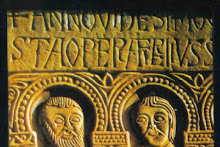martedì 1 dicembre 2009
sabato 6 giugno 2009
Puoti o comneno o Paleologo
Il Termine Paleologo deriva da Paliliologo da Palilie feste dedicate a Pothos o Venus o Aprile .Paleologo significa dinastia di Poto, ovvero Puoti
Il nome Paleologo e' attributo di Poto ovvero Puoti.Deriva dunque da Poto , interscambiabile con Komneno dal nome Komne Castrum Komne o Poti .Poto era nipote di Pothos ovvero Re Desiderio ,ilcui figlio Adelchimuto' nome a Costantinopoli , in Flavius Potus Teodatis Patricius Romanorum et bisantii , e fu pretendente al trono in virtu' della sua discendneza diretta da Costantino, attraverso Gallia Placidia e costanzo, figlio di Costantino
Il nome Paleologo e' attributo di Poto ovvero Puoti.Deriva dunque da Poto , interscambiabile con Komneno dal nome Komne Castrum Komne o Poti .Poto era nipote di Pothos ovvero Re Desiderio ,ilcui figlio Adelchimuto' nome a Costantinopoli , in Flavius Potus Teodatis Patricius Romanorum et bisantii , e fu pretendente al trono in virtu' della sua discendneza diretta da Costantino, attraverso Gallia Placidia e costanzo, figlio di Costantino
martedì 28 aprile 2009
Last Hohenstaufen
 Copyright © 1994-2002 Encyclopædia Britannica, Inc.
Copyright © 1994-2002 Encyclopædia Britannica, Inc. Sources Encylopedia Britannica 2002, Expanded ion DVD
The Hohenstaufen were a dynasty of Kings of Germany, many of whom were also crowned Holy Roman Emperor and Dukes of Swabia. The proper name, taken from their castle in Swabia, is Staufen.
When the last member of the Salian dynasty, Henry V, Holy Roman Emperor, died without an heir there was controversy about the succession. Frederick and Conrad, the two current male Staufens, were grandsons of Henry III, Holy Roman Emperor and nephews of Henry V. After the death of the intervening king and emperor Lothar III of Supplinburg, in 1137, Conrad became Conrad III of Germany.
Contents
1 Members of the Hohenstaufen family
1.1 Holy Roman Emperors and Kings of Germany
1.2 Dukes of Swabia
Members of the Hohenstaufen family
Holy Roman Emperors and Kings of Germany
Conrad III, king 1138-1152
Frederick I Barbarossa, king 1152-1190, Emperor after 1155
Henry VI, king 1190-1197, Emperor after 1191
Philip of Swabia, king 1198-1208
Frederick II, king 1208-1250, Emperor after 1220
Henry (VII), king 1220 - 1235 (under his father)
Conrad IV, king 1237-1254 (under his father)
The last ruling Hohenstaufen, Conrad IV, was never crowned emperor. After a 20 year period the first Habsburg was elected king.
Dukes of Swabia
Note: Some of the following dukes are already listed above as German Kings
Frederick I, Duke of Swabia (Friedrich) (r. 1079 - 1105)
Frederick II, Duke of Swabia (r. 1105 - 1147)
Frederick I, Holy Roman Emperor (Frederick III of Swabia)(r. 1147 - 1152) King in 1152 and Holy Roman Emperor in 1155
Frederick IV, Duke of Swabia (r. 1152 - 1167)
Frederick V, Duke of Swabia (r. 1167 - 1170)
Frederick VI, Duke of Swabia (r. 1170 - 1191)
Conrad II, Duke of Swabia (r. 1191 - 1196)
Philip of Swabia (r. 1196 - 1208) King in 1198
Frederick II, Holy Roman Emperor (r. 1212 - 1216) King in 1212 and Holy Roman Emperor in 1220
Henry (VII) of Germany (r. 1216 - 1235), King 1220 - 1235
Conrad IV (r. 1235 - 1254) King in 1237
Conrad V (Conradin) (r. 1254 - 1268)
See also: Dukes of Swabia family tree
See also
List of monarchs of Naples and Sicily. Hohenstaufen kings ruled in Sicily from 1194 till Manfred of Sicily was killed in the Battle of Benevento in 1266.
During the Third Reich, the Waffen-SS named an SS Panzer division Hohenstaufen in honour of this family.
also called Staufer Dynasty,
German dynasty that ruled the Holy Roman Empire from 1138 to 1208 and from 1212 to 1254. The founder of the line was the count Friedrich (died 1105), who built Staufen Castle in the Swabian Jura Mountains and was rewarded for his fidelity to Emperor Heinrich IV. (1050-1106) by being appointed duke of Swabia as Friedrich I in 1079. He later married Heinrich's daughter Agnes. His two sons, Friedrich II, duke of Swabia, and Konrad, were the heirs of their uncle, Emperor Heinrich V. (1086-1125), who died childless in 1125. After the interim reign of the Saxon Lothair III. (1075-1137), Konrad became German king and Holy Roman emperor as Konrad III. (1093-1152) in 1138. Subsequent Hohenstaufen rulers were Friedrich I. Barbarossa (1123-1190) (Holy Roman emperor 1155?90), Heinrich VI. (1165-1197) (Holy Roman emperor 1191?97), Philip of Swabia (king 1198? 1208), Friedrich II. (1194-1250) (king, 1212?50, emperor 1220?50), and Conrad IV (king 1237?54). The Hohenstaufen, especially Friedrich I and Friedrich II, continued the struggle with the papacy that began under their Salian predecessors, and were active in Italian affairs.
The Last Empress of imperial dynasty Avril von Hohenstaufen Burey Anjou Plantagenet is H.I.R.H. Princess Yasmine Aprile von Hohenstaufen Puoti (1946 Chateau Princes Puoti Palais Puoti- Villa di Briano)
Copyright © 1994-2002 Encyclopædia Britannica, Inc.
Sources Encylopedia Britannica 2002, Expanded ion DVD
domenica 8 marzo 2009
Хоен ( Hohen, Saint)штауфен( Staufen ,Genis) Staufer (Avril)
штауфеp(Avril)Хоен(Hohen ,Saint)штауфен( Staufen ,Genis)
venerdì 16 gennaio 2009
Dinastia dei Duchi di Normandia
Albero genealogico . I duchi di Normandia che precedettero Guglielmo il Conquistatore furono: Rogvald ,o Potente o Potone, figlio di Re Poto , nipote di Adelchi che arrivo' in Danimarca.Il figlio di Rogvald era Rollo 846-931 = Rollone "il Camminatore", *William I Longsword d. 942 = Guglielmo Lungaspada, *Richard I "the Fearless" d. 996 = Riccardo Senza Paura, *Richard II "the Good" d. 1026 = Riccardo il Buono, *Richard III, d.1027 = Riccardo III di Normandia, *Robert I "the Magnificent" d. 1035 = Roberto il Magnifico. Mentre i figli di Guglielmo il Conquistatore furono: *Robert II "Curthose" d. 1134 = Roberto il Corto o Cortacoscia, duca di Normandia, *William II "Rufus" d.1100 = Guglielmo II Rufus (il Rosso), re d'inghilterra, *Henry I "Beauclerc" d. 1135 = Enrico Beauclerc (il chierico), re d'inghilterrae poi anche duca di Normandia.
Iscriviti a:
Commenti (Atom)


